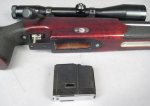Not exactly, it has more to do with where/when the work gets done. If I may:
On a 90* turn bolt action the bolt rotates from zero (horizontal out of battery position) to 90* (vertical in battery position). This trend to try and sell folks on the "less is more/better" thing in regards to bolt rotation is mumbo jumbo marketing crap imo. It's really as simple as put bolt in and take bolt out. The start and end point forms a right angle. -It reminds me of shopping for a hot rod camshaft. The "numbers" are often crap as its a marketing ploy.
Why this starts to matter: Within the given rotation a certain amount of work needs to be done. Most (not all, but most) center action designs hover around .225" to .250" of striker and striker spring compression. This is the linear distance generally required to accelerate the striker to sufficient velocity and kinetic energy to deliver a predictable and solid strike on the primer.
Springs are pretty consistent in rate of coils per inch, outside diameter, and wire gauge, heat treatment, etc. . .from one manufacturer to another. It's not until you go off the reservation with something like an RPA Quadlock action using Belleville washers for control of the striker that stuff really changes and becomes a bit more interesting.
-Two lug guns aren't all the far apart from one another.
So, why does one feel better/different than another? I would focus more on "different" than "better." This will explain why/how:
- Bolt handle length. As Archimedes stated, "Give me a lever long enough and I'll lift the world."
- Better attention paid to ensure cocking cam geometry is truly tangent to one another. -The aftermarket guys have this challenge solved. They all use good tools and understand them.
- Proper steel selection and heat treatment. Again, this is pretty much covered.
- Deciding where/when to do the work. I saved this for last because it's the biggest variance.
1. Partial cock on close, partial cock on open. AKA the 50/50 bolt design. You do 50% of the work coming up and the remaining 50% is taken care of when you lock it back up. How is this possible? You play around with the positioning of the cocking cam in relation to when/where it engages the lugs up front and the transfer bar of the trigger. If I engage the trigger's transfer bar prior to the lugs obtaining a purchase on the lug abutment flats, I have a partial cock on close type action. The lugs "pull" the bolt forward, causing the spring to be further compressed as you do so. You can easily demonstrate this with an M700. The "button" sticking out the ass end of the shroud is exposed more as you roll into battery.
2. Cock on open only. AKA the 105/-5 setup. You lift the bolt and you compress the fire control 105%. You drop the bolt down and it falls 5% as it locks up and engages the trigger. Here the cocking cam timing is retarded so that bolt lugs can bite onto the flats just prior to the fire control coming under load. Point is, all the work gets done coming up. Down is butter. So, do you wanna feel it split in half or all at once? That is what this boils down to.
It's a personal choice of one over the other. Both offer a compelling argument. Bench guys tend to favor a 105/-5 design. Those used to M700 designs are acclimated to the 50/50 so it becomes the bench standard for comparison of others. I like a 105/-5 because the shear load on the leading edges of the lugs is reduced. They aren't "climbing" the ramps. The risk of galling is reduced and I like the smoother feel it delivers when locking the gun up into battery.
It's purely a personal choice. There is no right/wrong answer here.
We've not even gone into the kinky side of this where acceleration rates, striker mass, energy delivery to the primer, and inertia (follow through) is considered to ensure were not bouncing the striker and causing fluctuations. This is just about
operating principle. My only point in sharing this is that maybe a few folks can understand a little better how some of this stuff actually works.
Enjoy your weekend.
C.



